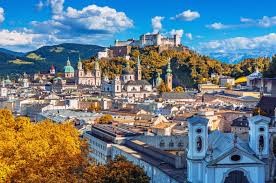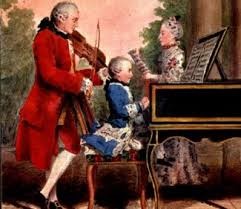Activity (4):

A-______________ Wolfgang Amadeus Mozart was born on 27 January 1756 to Leopold Mozart (1719–1787) and Anna Maria, in Salzburg. This was the capital of the Archbishopric of Salzburg, an ecclesiastic principality in what is now Austria, then part of the Holy Roman Empire. He was the youngest of seven children, five of whom died in infancy. His elder sister was Maria Anna Mozart (1751–1829), nicknamed “Nannerl”. Mozart was baptized the day after his birth. Leopold Mozart, a native of the city of Augsburg in Germany, was a minor composer and an experienced teacher. In 1743, he was appointed as fourth violinist in the musical establishment of Count Leopold Anton von Firmian. Four years later, he married Anna Maria in Salzburg. Leopold became the orchestra’s deputy in 1763. During the year of his son’s birth, Leopold published a violin textbook which achieved success.
B- ______________ In his early years, Wolfgang’s father was his only teacher. Along with music, he taught his children languages and academic subjects. Leopold was a devoted teacher to his children, but there is evidence that Mozart was keen to progress beyond what he was taught. His first ink-spattered composition and his precocious efforts with the violin were of his own initiative and came as a surprise to Leopold, who eventually gave up composing when his son’s musical talents became evident. Despite these artistic successes, Mozart grew increasingly discontented with Salzburg and redoubled his efforts to find a position elsewhere.
One reason was his low salary, 150 florins a year; Mozart longed to compose operas, and Salzburg provided only rare occasions for these. The situation worsened in 1775 when the court theatre was closed, especially since the other theatre in Salzburg was primarily reserved for visiting troupes. Two long expeditions in search of work interrupted this long Salzburg stay. Mozart and his father visited Vienna and Munich. Neither visit was successful, though the Munich journey resulted in a popular success with the premiere of Mozart’s opera La finta giardiniera.
C-______________ While Mozart was in Paris, his father was pursuing employment opportunities for him in Salzburg. With the support of the local nobility, Mozart was offered a post as court organist and concertmaster. After leaving Paris for Strasbourg, he lingered in Mannheim and Munich, still hoping to obtain an appointment outside Salzburg. In Munich, he again encountered Aloysia Weber, with whom he had once been in love, who was now a very successful singer, but she was no longer interested in him. Mozart finally returned to Salzburg and took up his new appointment, but his discontent with Salzburg remained undiminished. Among the better-known works which Mozart wrote on the Paris journey are the A minor piano sonata, K. 310/300d and the “Paris” Symphony (No. 31), which were performed in Paris.
D-______________ Mozart fell ill while in Prague for the 6 September 1791 premiere of his opera La clemenza di Tito, written in that same year on commission for the Emperor’s coronation festivities. He continued his professional functions for some time and conducted the premiere of The Magic Flute on 30 September. His health deteriorated, at which point he became bedridden, suffering from swelling, pain, and vomiting. Mozart was nursed in his final illness by his wife and her youngest sister and was attended by the family doctor, Thomas Franz Closset. He was mentally occupied with the task of finishing his Requiem. Mozart died in his home aged thirty-five.
